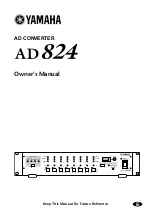
6
Chapter 3—Operation
AD824—Owner’s Manual
Setting the +48V Phantom Power Master
The +48V phantom power for all channels can be turned on and off by using the +48V
MASTER switch.
1
Set the +48V MASTER switch to the ON position to turn on the +48V phantom
power master supply.
The +48V MASTER indicator lights up.
2
Set the +48V MASTER switch to the OFF position to turn off the +48V phantom
power master supply.
The +48V MASTER indicator goes out.
Note that the c48V indicators remain lit when the +48V MASTER switch is set
to the OFF position.
Setting the Gain
The head-amp gain for each channel can be set individually.
1
Use the [SEL] buttons to select a channel.
The selected channel’s SEL indicator lights up and the gain setting appears on the GAIN
display.
2
Use the GAIN control to set the gain.
The gain can be set in 6 dB steps.
Controlling the AD824 Remotely
Using an exclusive control protocol, the AD824 can be remotely controlled from a
Yamaha DME32, personal computer, or other device connected to the COM PC/RS422
port. In addition, several AD824s can be remotely controlled by connecting them
together in a chain-like fashion by using both the COM PC/RS422 port and the COM
RS422 port.
When a control signal is detected, the GAIN display indicates the AD824’s ID number,
which is useful for identifying AD824s in a multiple-unit system. When an operation is
next performed on the AD824, the ID number disappears. ID numbers are determined
by the position of each AD824 in the connection chain and are set automatically.
The COM PC/RS422 switch should be set to RS422 when the COM PC/RS422 port is
connected to a DME32 or the next AD824 in a multiple-unit system, or PC when it’s
connected to a PC.
See “Personal Computer Connection” on page 11 and “Yamaha DME32 Connection”
on page 12 for hookup examples.
Note: When connecting to an AD824’s COM PC/RS422 port and COM RS422 port, be
careful not to create a loop connection between them.
























